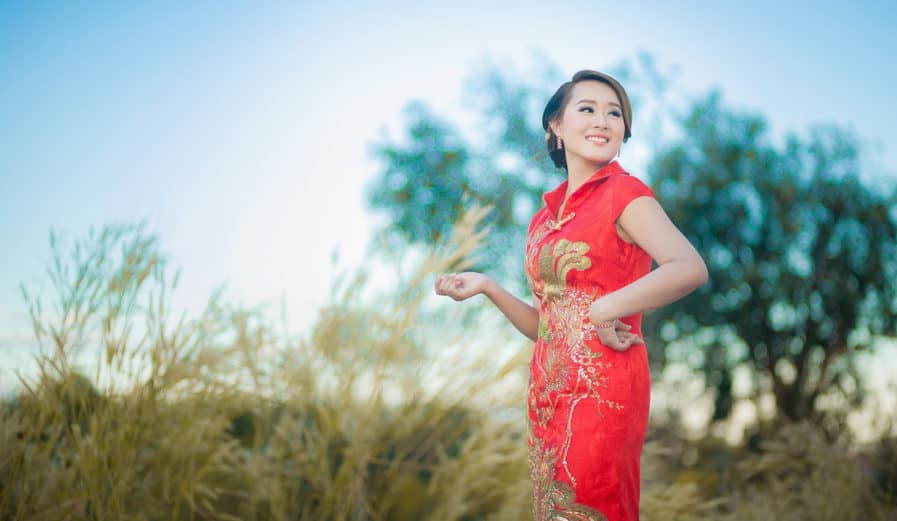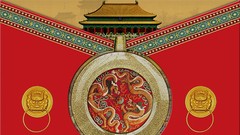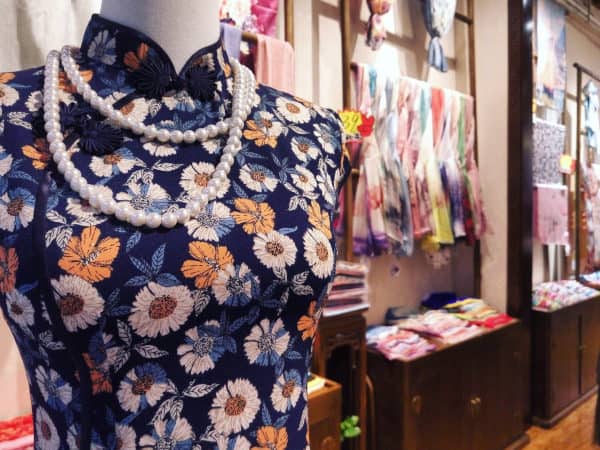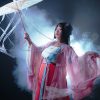
The Chinese Qipao, or often called Cheongsam in the West, ls one of the most important fashion items and symbols of modern China. However, the origin and history of Qipao are shrouded in mystery, and there are many misconceptions and myths surrounding the Cheongsam.
Here, we will discuss all the ins and outs of the Chinese Qipao from its history, the transformation of its design, and facts you may want to know.
Let us begin with the first one.
Qipao VS Cheongsam
The Chinese Qipao or Cheongsam are terms that can be used interchangeably.
The term cheongsam is an English loanword, a romanization of the Cantonese word 衫, Chèuhngsam, and is commonly used to describe the close-fitting Chinese dress worn by females that is popularized in Shanghai around the 1920s (more on this later). In the Shanghainese dialect, we use the term zansae to describe the same dress.
Qípáo, on the other hand, is a Mandarin Chinese word.
The usage of both terms can vary depending on the location where they are used. In Hongkong, for example, the term Cheongsam or Chèuhngsam is now used as a gender-neutral term and can refer to both traditional garments for males and females. In China, however, Qipao is exclusively used for the female version of the garment, and we can use Chángshn (衫)to refer to the male garment.
In western countries, the terms Cheongsam and Qipao are generally applied to the female garment worn by women only.
The History of Qipao (Cheongsam)
Historical Background
The story of Cheongsam—or Qipao—, began during the time of the Qing dynasty, the last imperial dynasty of China that ruled between 1636 to 1911. This is the time when the Manchu people ruled China.
The Manchus used an administrative system called the Eight Banners ( jakūn gūsa in Manchu), which was established by the chieftain Nurhachi—ruled between 1559 to 1626). In this system, the Manchu people wore different clothing than ordinary civilians (including the oppressed Han Chinese and Mongols).
The Manchu people wore long robes that are called changpao (袍) for both men and women, although the term qipao (旗袍 meaning, banner gown) was also commonly used to describe the dress worn by Manchu women.
In 1936, a dynastic law was implemented so that all Han Chinese must adopt changpao and Manchu hairstyle instead of Han Chinese traditions. Later on, the law was lifted and only Han Chinese who served as scholars or public officials were required to use changpao. Over time, however, Han civilian men voluntarily adopt the changpao, while for women, qipao and the Han clothing systems have always coexisted throughout the time of the Qing dynasty.
Check out our “Free Culture Library“. We have compiled some great free resources, about Chinese culture, for your research.
Online Courses about Chinese Culture from Udemy (Aff.link)

The Modern Qipao
It’s worth noting that the original qipao or cheongsam for women during the Qing dynasty—as discussed above— didn’t look similar to a typical cheongsam we can see in China today. This original’ qipao fitted rather loosely (baggy) and hung in an A-shaped line to cover most of the wearer’s body except the toes, hands, and head.
The version of qipao we have today was introduced and popularized in the 1920s to 1940s in Shanghai. The cheongsam was then modernized and worn by the celebrities and upper-class women in Shanghai.
We cannot separate the history of modern qipao with the late Madame Wellington Koo—maiden name Oei Hui Lan—, the former First Lady of China who was also voted several times by Vogue as one of the best-dressed women in 1942.
Madame Wellington Koo was famous for her modernized adaptation of the Cheongsam. Back then, Cheongsam dresses had been slashed just a few inches up the sides and Madame Wellington Koo slit hers up to one knee—similar to what we know today—. Madame Koo also insisted on using only local Chinese silks.
When the Communist government ruled China in 1949, the dress became less popular in China, since the Communists tried to push for modernizations and erase traditional values, including fashions. Many people back then escaped to Hong Kong (back then, British-controlled), where the Qipao remains popular until the 1950s.
Click here to see some awesome Chinese Qipao Dresses, Qipao Tops and Qipao for Girls– Opens in new tab.

Transformation of the Qipao
As mentioned above, the original’ Qipao during the times of the Qing dynasty (the Manchu rule) was rather loose and baggy, featuring a relatively straight skirt model—compared to what we have today— and higher neckline. Back then, it covered almost all of the woman’s body except for a little bit of the toes, both hands, and the head. Intricate embroidery was also a very important characteristic of the Cheongsam design (it still is today but to a lesser extent.)
In the 1920s, the Cheongsam or Qipao was always worn with trousers—for both males and females—. However, with the integration of Western fashion items during the 1930s Hong Kong, stockings slowly but surely replaced trousers, and the side slits are now higher reaching above the knees or even the top of thighs, reflecting the fashion trends back then.
By the 1940s, trousers went out of popularity and were completely replaced by mainly stockings and leggings. During this time, high-heeled shoes were also introduced to Shanghai as a new fashion trend, and have continued to be an essential part of the Cheongsam fashion until today.
As the fashion trends went to be more modern’, women started to wear Cheongsam with bare legs and neglect the use of hosiery (leggings, etc.), and so Cheongsam finally evolved as the form we know today as a one-piece, tight-fitting dress.
Western fashions evolved during all these years and have also influenced the transformation of Qipao design to involve more accentuation, high-necked sleeveless designs, and bell-like sleeves. By the 1940s, the modern design of Qipao has mostly matured’ to be the form we know today, and featured a wide variety of fabric and motive choices, along with various accessories.

When Should We Wear a Cheongsam
Back in the time of the Qing dynasty—in the 17th century—, Chinese women wore a cheongsam or qipao almost daily, and the qipao was also worn quite often as a casual fashion item during the 1920s Shanghai and 1950s-1960s Hong Kong.
Today, in China and other countries with Chinese tradition, Qipao is generally not worn as an everyday dress but is still common attire for formal occasions like:
- Weddings: the Cheongsam/Qipao is a common choice for Chinese weddings or even in western weddings when a bride is of Chinese descent or is marrying into a Chinese family. As a guest, wearing a Qipao to attend the wedding is also considered appropriate.
- School uniform: Qipao is used as an official school uniform in a few primary and secondary schools in Hong Kong, mainly older Christian and Catholic schools.
- Workplace attire: Cheongsam is used as a uniform in restaurants and hotels, and is also a common choice of flight attendant uniforms and ground workers for airlines in Mainland China, Taiwan, and countries with Chinese influence like Singapore.
- Chinese New Year: the Cheongsam or Qipao is a common attire choice to wear during Chinese New Year and other Chinese traditional festivals (Further reading: 9 Major Chinese Festivals that You Need to Know).
- International fashion: as China grows in popularity as an economic and cultural superpower, many fashion designers (including Western ones) have adopted Cheongsam and elements of the Cheongsam in their collections. Also, many Hollywood films have featured Cheongsam as a fashion choice, including by non-Chinese actors like Anne Hathaway, Elizabeth Taylor, and Nicole Kidman, among others.
- As a Chinese identity: the Cheongsam or Qipao is lately revisited as an identity of being a Chinese descent and is often used in politics, sports (i.e. medal bearers in 2008 Summer Olympics), and other diplomatic occasions.
How To Wear a Modern Qipao Right
Here are some useful tips before you invest in a nice Cheongsam:
- The Qipao might or might not feature cap sleeves. In general, cap sleeves are more suitable for those with thinner arms.
- Thinner collars can help elongate your neck, while deeper collars can shorten’ it. The collar is typically 6 cm high, but there are shorter collars of 3 cm or lower.
- You can always opt for a sleeveless version if you want your arms to look longer and thinner.
- When considering a qipao’s tightness, make sure you can sit comfortably in it. Test it by sitting down and make sure it doesn’t go past the mid-thigh. Also, you should be able to cross your legs comfortably.
- There are many different options for fabric choices. As a general rule of thumb, you should choose a fabric that can fit your body nicely without forming creases.
- If you have a heavy bottom and are rather uncomfortable with tight skirts, you can always opt for skirts featuring A-line with a gentle flare. This can divert attention from the lower half of your body.
Click here to see some awesome Chinese Qipao Dresses, Qipao Tops and Qipao for Girls– Opens in new tab.
End Words
Contrary to common misconception, Qipao—or Cheongsam— is a fairly modern Chinese fashion, introduced only’ in the 17th history and has gained popularity during the early 20th century, to be exact during the 1920s in Shanghai.
Even though it has a relatively short history, the Qipao has been popularized as one of the most important Chinese fashion symbols, strongly associated with the Chinese ethnic identity. It is now not only popular among the Chinese and even Asia, but also popular in the West and Hollywood.
Stay in Touch
 Join our newsletter by using the forms on this website or click here!
Join our newsletter by using the forms on this website or click here! Follow us on Google News
Follow us on Google News Follow us on Facebook
Follow us on Facebook
Featured Image by Pxhere.com


